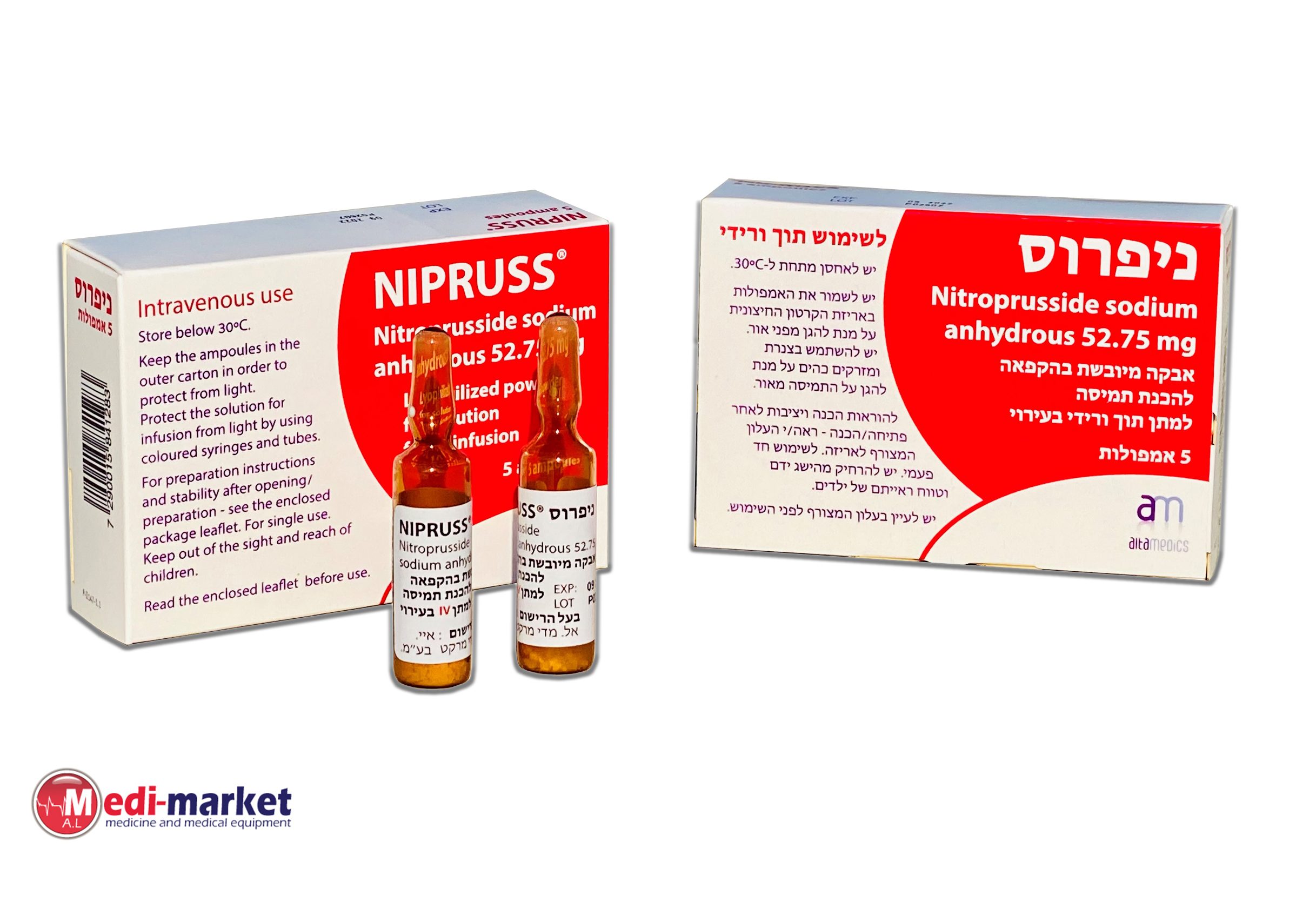Quest for the right Drug

ניפרוס NIPRUSS ® (NITROPRUSSIDE SODIUM ANHYDROUS)
תרופה במרשם
תרופה בסל
נרקוטיקה
ציטוטוקסיקה
צורת מתן:
תוך-ורידי : I.V
צורת מינון:
אבקה להכנת תמיסה לאינפוזיה : POWDER FOR SOLUTION FOR INFUSION
עלון לרופא
מינוניםPosology התוויות
Indications תופעות לוואי
Adverse reactions התוויות נגד
Contraindications אינטראקציות
Interactions מינון יתר
Overdose הריון/הנקה
Pregnancy & Lactation אוכלוסיות מיוחדות
Special populations תכונות פרמקולוגיות
Pharmacological properties מידע רוקחי
Pharmaceutical particulars אזהרת שימוש
Special Warning עלון לרופא
Physicians Leaflet
Pharmacological properties : תכונות פרמקולוגיות
Pharmacodynamic Properties
5.1 Pharmacodynamic properties ATC-Code: C02DD01 Pharmacotherapeutic group: anti-hypertensives, agents acting on arteriolar smooth muscle. Mechanism of action Sodium nitroprusside has a dilating effect on the muscles of the precapillary arterioles and of the venous capacitance vessels. The tone-decreasing effect on veins and arteries is roughly the same. Venodilation causes venous pooling with a decrease in cardiac preload and a reduction in increased filling pressures. Arteriolar dilation leads to a reduction in blood pressure, a decrease in peripheral arterial resistance and a reduction in the cardiac afterload. Sodium nitroprusside leads to dilation of the major coronary arteries. Smooth muscles with a predominantly phasic activity – such as the duodenum and uterus – are not very sensitive to the effect of sodium nitroprusside. The antihypertensive effect is characterised by an unusually steep dose-response curve. In a healthy heart, the cardiac output remains practically unchanged. In patients with cardiac insufficiency it is significantly increased depending on the initial situation. Sodium nitroprusside causes reflectory stimulation of the sympathetic nervous system with tachycardia and stimulation of renin secretion, especially in the alert state. Sodium nitroprusside inhibits platelet aggregation triggered in vitro by collagen, ADP and adrenaline and decreases the number of circulating platelet aggregates in vivo. Pharmacodynamic properties See "mechanism of action". Clinical efficacy Hypertensive crisis: Regarding the scientific basis for treatment decisions there have been no large clinical studies, no randomised nor placebo-controlled studies. The treatment is usually dictated by consensus and expert opinions. The particular features of the clinical situation and the end-organ complications and not the absolute value of blood pressure therefore should be considered. Controlled hypotension: Baseline-controlled clinical studies have uniformly shown that sodium nitroprusside has an immediate vasodilating effect in all populations. With increasing rates of infusion, sodium nitroprusside has been able to lower blood pressure without an observed limit of effect. Clinical studies have also shown that the hypotensive effect of sodium nitroprusside is associated with reduced blood loss in a variety of major surgical procedures. Safety and efficacy in children / adolescents The safety and efficacy of sodium nitroprusside in children and adolescents under 18 years of age have been determined from adult studies and 2 clinical studies in children under 17 years of age. No new safety concerns were identified in the studies in children and adolescents versus adults. Two clinical studies in the USA with intravenous sodium nitroprusside for the indication "severe hypertension" have also proven the effectiveness, tolerability and safety in the patient subpopulation of children and adolescents (under 17 years of age). The first study included 203 individuals and was conducted as a phase 2 multicentre randomised, double-blind, parallel group, dose-ranging, effect-controlled study. A second phase 2 multicentre interventional randomised, double-blind, placebo-controlled safety-related study was conducted from 2008 to 2011 in 45 patients.
Pharmacokinetic Properties
5.2 Pharmacokinetic properties Absorption Sodium nitroprusside is administered by intravenous infusion only and is thus 100% bioavailable. Distribution Owing to the exceedingly short life of sodium nitroprusside, protein binding and distribution are not known. There is no accumulation of the substance in specific tissues (e.g. the vascular walls). Biotransformation Sodium nitroprusside is rapidly metabolised to cyanide, 30 - 50% are detected in the blood, the rest in tissues. Cyanide binds partly to haemoglobin. Cyanide is converted to thiocyanate by means of sulphur donors, first and foremost thiosulfate. The availability of substrates containing sulphur is the speed-limiting factor. Elimination For thiosulfate, the optimal substrate concentration is around 3 mol thiosulfate per 1 mol cyanide. The conversion rate of cyanide to thiocyanate in humans is around 0.05 mg CN-/kg/min. Higher sodium nitroprusside doses lead to a cumulation in the serum concentration of thiocyanate, because this metabolite is formed faster than it is excreted by the kidneys. The thiocyanate clearance is 2.2 mL/kg/min in renally healthy patients and lower in patients with renal impairment.

שימוש לפי פנקס קופ''ח כללית 1994
לא צוין
תאריך הכללה מקורי בסל
לא צוין
הגבלות
לא צוין
מידע נוסף
